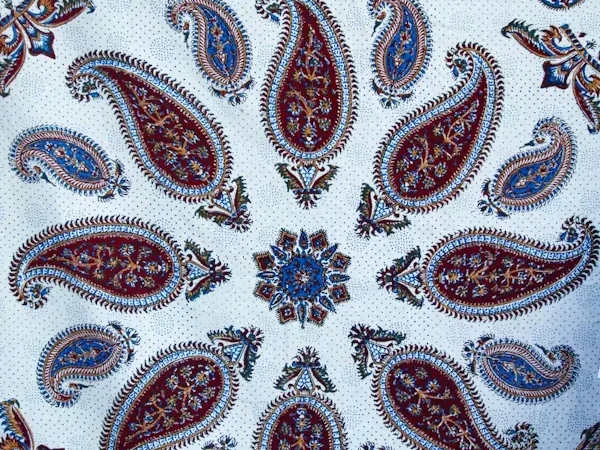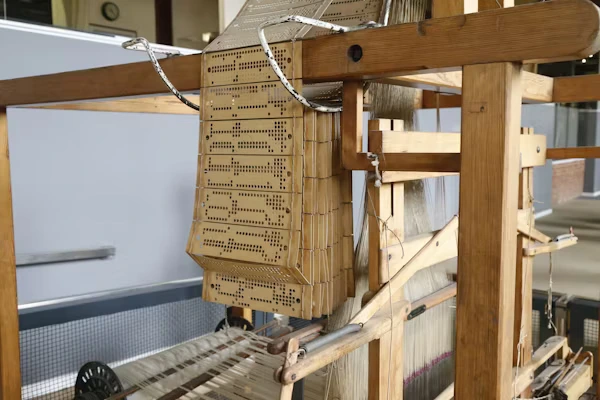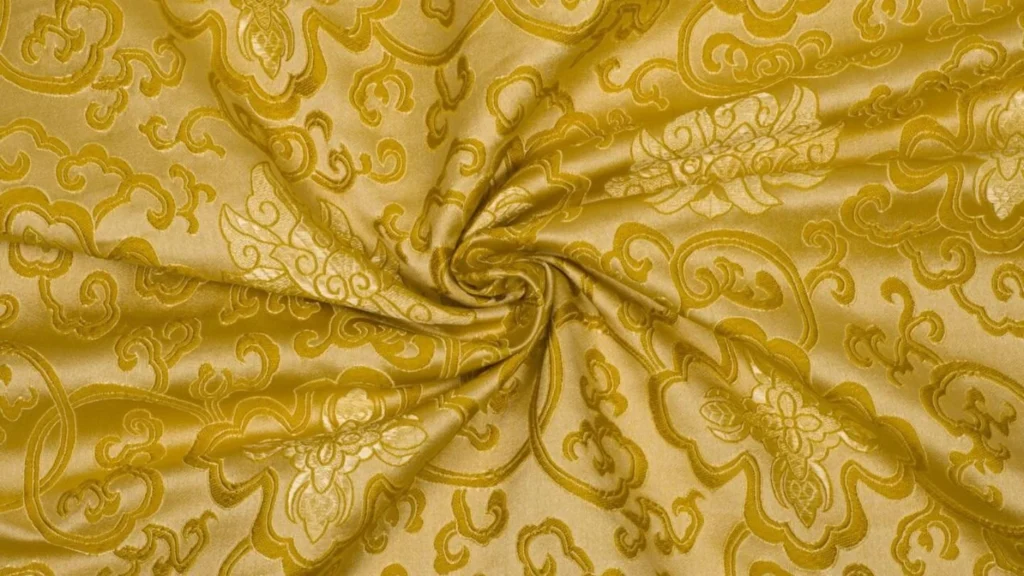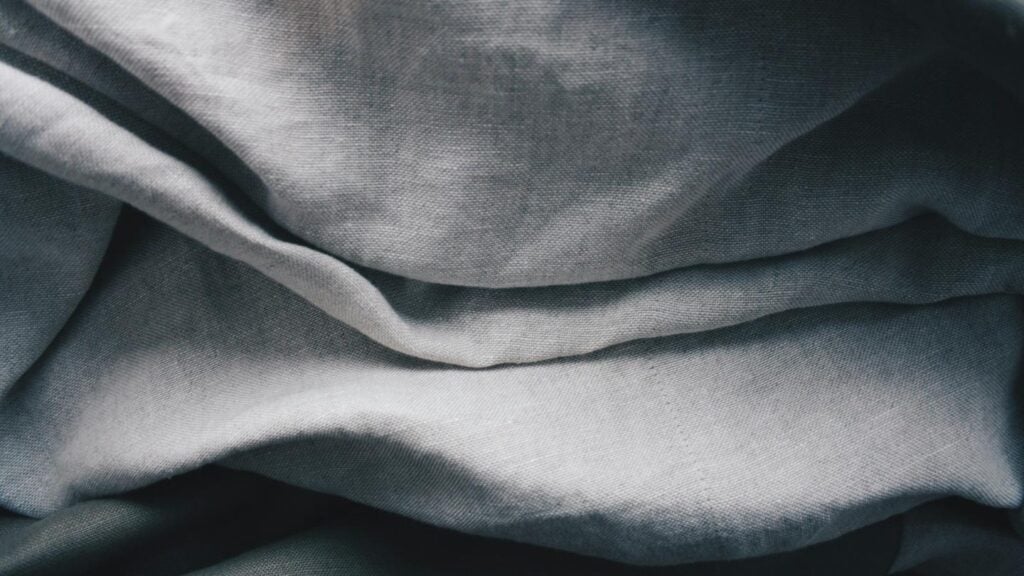2 – Damask Fabric Composition
3 – Damask Fabric vs Other Fabrics
4 – How Damask Fabric Is Manufactured
5 – Common Uses in Fashion
6 – Understanding the Environmental Impact of Damask Fabric
7 – Exploring Price Points and Value for Money
8 – Conclusion
9 – FAQs
What is Damask Fabric?
Damask fabric is a luxurious, reversible textile known for its intricate patterns, often characterized by its rich texture and sheen. Traditionally made from silk, modern versions of damask are now produced using a variety of materials, including cotton, linen, and synthetic fibers. Damask gets its name from the city of Damascus, where the fabric was first created, dating back to ancient times. The fabric is primarily known for its Jacquard weaving technique, which allows for the creation of complex patterns and designs, making each piece of damask unique and highly decorative.

Key Features of Damask Fabric
- Reversible Patterns: The design is woven into the fabric, which means both sides are often equally attractive, making it versatile for various applications.
- Luxe Feel and Look: Damask fabric has a soft, rich texture and often carries a sheen, thanks to the different thread variations used in its weaving.
- Durability: Despite its delicate appearance, damask is a durable fabric, particularly when made from cotton or linen. It resists wear and tear and can last for many years.
Damask fabric is used in both fashion and home décor, bringing an elegant, timeless touch to garments and interiors. Its luxurious appeal, combined with its versatility, has made it a staple for high-end products ranging from evening wear to upholstery.
Damask Fabric Composition
Damask fabric is primarily made from silk, cotton, linen, or synthetic fibers, with the choice of material influencing its texture, durability, and cost. The composition of damask determines its overall feel and appearance, making it suitable for different applications, from luxury garments to home décor.
- Silk Damask: Traditionally, damask was made from silk, offering a rich, lustrous finish. Silk damask is often used in high-end fashion, evening wear, and upholstery due to its luxurious appearance.
- Cotton Damask: Modern versions are frequently made from cotton, which makes it more affordable while maintaining a similar appearance to silk. Cotton damask is commonly used for tablecloths, bedding, and upholstery due to its durability and comfort.
- Linen Damask: Linen damask is highly valued for its cool, breathable qualities, making it perfect for summer garments or home textiles like curtains and cushions. It’s less glossy than silk but has a more rustic, sophisticated look.
- Synthetic Damask: Some modern damask fabrics are made from synthetic fibers like polyester. These options are often more affordable and durable, but they lack the natural sheen of silk and may not feel as luxurious.

The Jacquard weaving technique is used for all damask fabrics, where intricate patterns are woven into the fabric, creating a raised design that is visible on both sides. This technique allows for the use of multiple fibers in a single weave, enhancing the texture and complexity of the fabric.
Damask Fabric vs Other Fabrics
When compared to other fabrics, damask stands out for its luxurious texture, intricate patterns, and versatility. While it shares some qualities with other woven fabrics, it also has distinct advantages that make it a favorite in both fashion and home décor.
Damask vs. Brocade
- Texture and Design: Both fabrics are woven with intricate patterns, but damask typically has a reversible design, while brocade patterns are often more raised and dense. Brocade tends to be thicker and stiffer, while damask is softer and more fluid.
- Use: Damask is used for more versatile applications, from lightweight garments to upholstery, while brocade is often reserved for formal or decorative pieces.
Damask vs. Velvet
- Shine and Feel: While velvet is known for its plush texture and rich depth, damask is softer with a smooth, glossy finish. Velvet’s pile gives it a distinct tactile feel, while damask has a more refined, flat texture with a lustrous sheen.
- Durability: Damask is generally more durable than velvet, which can wear down more quickly and is more prone to damage from pressure or dirt.
Damask vs. Polyester
- Eco-Friendliness and Feel: Damask made from natural fibers like cotton or silk offers a much more luxurious feel compared to synthetic polyester, which can feel stiff and less breathable.
- Durability and Cost: Polyester is more affordable and durable, making it a popular choice for budget-conscious consumers. However, it lacks the elegance and complexity of damask fabrics, especially when it comes to the rich texture and appearance.
How Damask Fabric Is Manufactured
The production of damask fabric is a meticulous process that combines advanced weaving techniques with high-quality materials. Unlike basic woven fabrics, damask uses a Jacquard loom, which allows for the creation of intricate, reversible patterns directly within the fabric. Here’s a step-by-step breakdown of how damask fabric is made:

- Choosing the Material
The first step in manufacturing damask fabric is selecting the material. Damask can be made from silk, cotton, linen, or synthetic fibers. The choice of fiber affects the fabric’s texture, sheen, and overall durability.
- Preparing the Yarn
Once the material is selected, the yarn is prepared by winding it onto spools. For damask, multiple threads are used simultaneously to create depth and texture in the pattern. Different threads can be used for the background and the pattern, giving the fabric its signature contrast.
- Setting Up the Jacquard Loom
The Jacquard loom is a specialized weaving machine that can create highly detailed patterns. The loom is programmed with a pattern design, which can range from simple geometric shapes to intricate floral motifs. The Jacquard mechanism lifts specific threads based on the design instructions, allowing for complex patterns to be woven into the fabric.
- Weaving the Fabric
With the yarn prepared and the loom set up, the weaving process begins. Damask fabric is typically woven using a satin weave, where the threads flow smoothly over and under each other to create a shiny, lustrous surface. The Jacquard loom allows for a reversible design, meaning the same pattern is visible on both sides of the fabric.
- Finishing and Dyeing
After the fabric is woven, it undergoes finishing processes that enhance its appearance and feel. This can include dyeing, softening, or embossing the fabric. The dyeing process is crucial, especially for silk damask, as it helps to bring out the rich colors and patterns. For cotton or linen damask, the fabric may be softened to improve its drape and texture.
- Quality Control
Once the fabric is finished, it undergoes a strict quality control process. Each roll of fabric is inspected for defects in the weave, pattern, and color consistency. High-end damask fabrics are thoroughly checked to ensure the intricate designs are flawless.

Produce your fashion collection with us
Common Uses in Fashion
Damask fabric is highly prized for its luxurious appearance, intricate patterns, and versatility, making it a popular choice for various fashion applications. Known for its sheen and rich texture, damask is often associated with high-end fashion and special occasions. Here are some of the most common uses of Damask fabric in fashion:
- Evening Wear and Formal Attire
Damask’s rich texture and elegant sheen make it a go-to choice for evening gowns, cocktail dresses, and formal wear. Its luxurious appearance adds an element of sophistication, perfect for special events like galas, weddings, and red carpet occasions. The fabric’s ability to reflect light gives it a glamorous quality, making it ideal for high-fashion designs. - Upholstered Garments
Due to its durability and the ability to retain its pattern, damask is often used in jackets, coats, and suits. These garments benefit from the fabric’s luxurious texture and strong structure, making them both stylish and durable. Damask can also be used for blazers and other structured outerwear that require a fabric with body and weight. - Accessories
Damask is not just for clothing—it’s also used in creating luxury accessories. Items like scarves, shawls, bags, and belts made from damask fabric provide a unique way to incorporate intricate patterns into an outfit. The fabric’s softness, sheen, and reversible design make it a standout for accessories that add elegance to both casual and formal looks. - Bridal and Special Occasion Wear
Damask fabric’s association with luxury makes it a natural choice for bridal gowns and wedding attire. The fabric’s intricate patterns and elegant drape make it an excellent option for dresses that require both visual appeal and structure. It’s also commonly used in bridesmaid dresses, flower girl gowns, and wedding accessories like veils or headpieces. - Home Fashion
In addition to clothing, damask is often used in home fashion for luxury curtains, cushions, and upholstery. Its texture and pattern make it a favorite in creating a sophisticated atmosphere in home décor. High-end bedding sets and tablecloths made from Damask fabric add a touch of elegance to any room. - Costumes and Historical Fashion
Damask is frequently used in the creation of historical costumes or theatrical attire, where rich, intricate fabrics are required to replicate the appearance of the past. The fabric’s luxurious texture and classic patterns are perfect for period costumes, including Renaissance, Baroque, or Victorian-style outfits.

Understanding the Environmental Impact of Damask Fabric
Damask fabric’s environmental impact varies depending on the materials used and the production process. Here are key points:
Materials:
- Silk Damask is biodegradable and renewable.
- Cotton Damask is renewable and sustainable cotton farming can reduce any impacts.
- Synthetic Damask (e.g., polyester) can make the fabric more durable and have longer lifespans.
Production Process
- The Jacquard weaving technique used in damask production isn’t resource-heavy, but finishing processes like dyeing can involve chemicals and energy. Eco-friendly dyeing methods are being adopted to reduce waste.
Durability
- Damask, especially when made from natural fibers, is durable and long-lasting, reducing the need for frequent replacements and minimizing waste.
End-of-Life:
- Cotton and silk damask are biodegradable, whereas synthetic Damask isn’t, but can be repurposed and recycled.
Exploring Price Points and Value for Money
The price of damask fabric varies depending on the material, design complexity, and production methods. While it’s generally considered a high-end fabric, it offers significant value for money due to its durability, luxurious feel, and versatile applications. Here’s a breakdown of damask fabric’s pricing and value:
Price Range:
- Silk Damask is the most expensive, typically ranging from €50 to €150 per meter due to its luxurious nature and the labor-intensive production process.
- Cotton Damask is more affordable, usually priced between €20 and €60 per meter, depending on the quality and finish.
- Synthetic Damask made from polyester or nylon is the most budget-friendly, ranging from €10 to €30 per meter.
Value for Money:
- Durability: Damask, especially cotton and silk variants, is highly durable and can last for years, making it a good long-term investment.
- Luxurious Appearance: Damask provides the luxurious look and feel of high-end fabrics like brocade and velvet, but at a lower price, particularly when made from cotton or synthetics.
- Versatility: Damask’s wide range of uses—from formal wear to home décor—means it offers great value in various settings. It enhances both fashion and interior design, making it a versatile addition to any wardrobe or space.

Why Choose Damask?
Damask provides a premium aesthetic at a reasonable price compared to silk and other luxurious fabrics. While it may have a higher upfront cost than basic textiles, its long-lasting nature, elegant look, and eco-friendliness make it an economical choice in the long run.
Conclusion
Damask fabric is a luxurious, durable textile known for its intricate patterns and sheen. Made from silk, cotton, or synthetics, it offers excellent value due to its longevity, versatility, and timeless elegance. Though it may come at a higher cost, damask is a sustainable and worthwhile investment for both fashion and home décor, combining luxury with practicality.
FAQs
- What is Damask fabric?
Damask fabric is a luxurious, reversible textile known for its intricate patterns, often created using the Jacquard weaving technique. It is commonly made from silk, cotton, or synthetic fibers.
- Where does Damask fabric come from?
Damask originated in the ancient city of Damascus, where it was first developed, traditionally using silk.
- What are the key properties of Damask fabric?
Damask is known for its soft texture, durability, shine, and reversible patterns, making it ideal for high-end fashion and home décor.
- How is Damask fabric made?
Damask is woven using the Jacquard loom, which allows for the creation of complex, reversible patterns. The process involves weaving threads of different materials, such as silk, cotton, or polyester.
- Why is Damask fabric so expensive?
Damask, particularly when made from silk, is expensive due to its intricate weaving process, high-quality materials, and luxurious finish.
- Is Damask fabric environmentally friendly?
Damask made from natural fibers like silk or cotton is biodegradable and eco-friendly, but synthetic versions made from polyester are less sustainable.
- How do I care for Damask fabric?
Damask fabric should be cleaned gently, usually by hand or dry cleaning, to preserve its intricate patterns and sheen. It should be stored in a cool, dry place to maintain its texture.
- What is the difference between Damask and brocade?
While both are luxurious fabrics with intricate patterns, damask is usually lighter, with reversible designs, while brocade has more raised patterns and is typically thicker.
- Can Damask fabric be used for upholstery?
Yes, damask is commonly used for upholstery due to its durability and elegant patterns, making it perfect for furniture like sofas and cushions.
- Is Damask fabric suitable for everyday wear?
Damask is typically used for special occasions or formal wear due to its luxurious feel, though it can also be used for accessories and light garments.







